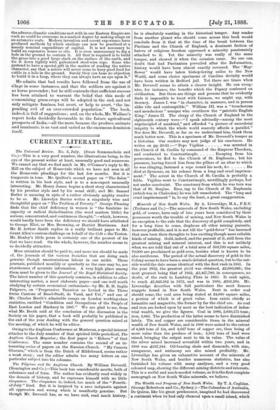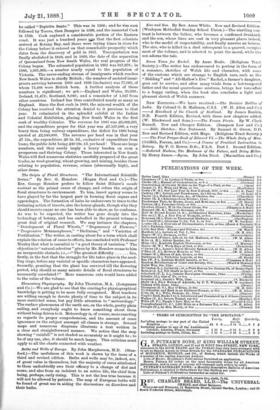The Wealth and Progress of New South Wales. By T.
A. Coghlan. (George Robertson and Co., Sydney.)—The Columbus of Australia, De Quiros, like his great predecessor, imagined he had discovered a continent when he had only chanced upon a small island, which he called "Espiritu Santo." This was in 1606; and he was soon followed by Torres, then Dampier in 1699, and the immortal Cook in 1769. Cook explored a considerable portion of the Eastern coast. It was just a hundred years up that the first colonists arrived at Botany Bay, and there were trying times in store for the Colony before it entered on that remarkable prosperity which dates from the discovery of gold in 1851. Transportation was finally abolished in 1849, and in 1860, the date of the separation of Queensland from New South Wales, the real progress of the 'Colony began. The estimated population in 1861 was 357,978 ; in 1886, 1,001,966,—a number nearly equal to the population of Victoria. The never-ending stream of immigrants which reaches New South Wales is chiefly British ; the number of assisted immi- grants arriving between 1860 and 1886 (inclusive) was 77,095, of whom 75,468 were British born. A further analysis of these numbers is significant ; we get :—England and Wales, 35,950 ; Ireland, 31,472; Scotland, 8,046; and a remainder of 1,627 from other countries. Ireland has thus contributed nearly as many as England. Since the first rush in 1860, the mineral wealth of the Colony has received the attention denied to it previous to that year. It culminated in the splendid exhibit at the Indian and Colonial Exhibition, placing New South Wales in the first rank of wealthy Colonies. The revenue for 1886 was £3,089,235, and the expenditure proper for that year was £7,167,689, a very heavy item being railway expenditure, the deficit for 1886 being quoted at £2,540,000. The revenue per head was in that year £7 15s., the expenditure £9 5s. 3d., exclusive of expenditure from loans, the public debt being £4019s. id. per head ! These are large numbers, and they surely imply a heavy burden on even a prosperous and thriving Colony. Those interested in New South Wales will find numerous statistics carefully prepared of the great trades, as wool-growing; wheat-growing, and mining, besides those relating to population, revenue, crimes (abnormally high), and .other items.



































 Previous page
Previous page